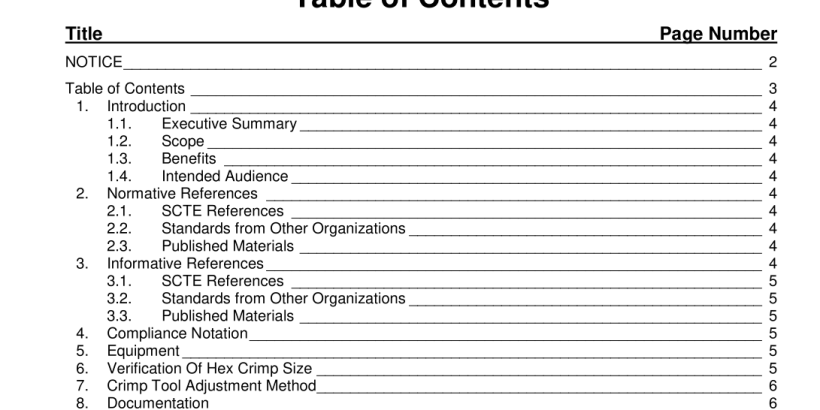ANSI SCTE 14-2016 pdf download.Test Method for Hex Crimp Tool Verification/Calibration
1.2. Scope
To determine and verify the actual crimp dimension of hex crimp tools. Provide a calibration technique for adjusting hex crimp tools.
1.3. Benefits
Crimp tools can go out of adjustment with use, potentially resulting in performance impairments such as low cable retention, shielding degradation, poor grounding and generation of unwanted intermodulation signals. Properly adjusted tools will ensure connector/cable junction performance in accordance with connector manufacturer’s published specifications.
1.4. Intended
Audience Installers, maintenance technicians and field supervisors 2. Normative References The following documents contain provisions, which, through reference in this text, constitute provisions of this document. At the time of Subcommittee approval, the editions indicated were valid. All documents are subject to revision; and while parties to any agreement based on this document are encouraged to investigate the possibility of applying the most recent editions of the documents listed below, they are reminded that newer editions of those documents might not be compatible with the referenced version.
2.1. SCTE References
• No normative references are applicable.
2.2. Standards from Other Organizations
• No normative references are applicable.
2.3. Published Materials
• No normative references are applicable.
3. Informative References
The following documents might provide valuable information to the reader but are not required when complying with this document.
3.1. SCTE References
• No informative references are applicable.
3.2. Standards from Other Organizations
• No informative references are applicable.
3.3. Published Materials
• No informative references are applicable.
4. Compliance Notation
This word or the adjective“required”‘ means that the item is an absolute requirement of this document. This phrase means that the item is an absolute prohibition of this document. This word means the value specified shall never be used. This word or the adjective“recommended’ means that there may exist valid reasons in particular circumstances to ignore this item, but the full implications should be understood and the case carefully weighted before choosing a different course. This phrase means that there may exist valid reasons in particular circumstances when the listed behavior is acceptable or even useful, but the full implications should be understood and the case carefully weighed before implementing any behavior described with this label. This word or the adjective“optional’ means that this item is truly optional. One vendor may choose to include the item because a particular marketplace requires it or because it enhances the product, for example; another vendor may omit the same item. Use is permissible for legacy purposes only. Deprecated features may be removed from future versions of this document. Implementations should avoid use of deprecated features.
5. Equipment
Machinist’s outside micrometer having a flat anvil and flat spindle, calibrated to read directly to at least 0.005 inch (0.127 mm), with each division of a width that facilitates estimation of each measurement to 0.0005 inch (0.0127 mm). As an alternate use digital calipers calibrated to read directly to at least 0.0005 inch (0.0127 mm).
6. Verification Of Hex Crimp Size
1. Crimp an empty F-fitting (no cable) of the appropriate size in the front-most hex cavity.
2. Using a micrometer or digital caliper, measure and record the dimensions across each of the three sets of hex flats.
No single measurement across hex flats should deviate more than ± 0.005 inch (± 0.127 mm) of the published hex size.
3. Average the three measurements recorded in the above step.
The average hex crimp measurement should be within ± 0.003 inch (0.076 mm) of the published hex size.
Repeat procedures above for each hex cavity.
If discrepant measurements are obtained, proceed to section 7, Adjustment Method.ANSI SCTE 14-2016 pdf download
